As a beginner aquarium enthusiast, I was overwhelmed with the number of options available for background plants in my aquatic home. Live plants not only add beauty to your aquarium, but they also promote fish health and water quality. However, selecting the right plants can be daunting without proper guidance. That’s why I’ve put together a list of the 20 best beginner-friendly background plants for aquariums.
With these plant options, you won’t have to worry about difficult care or maintenance requirements. These plants are hardy and will provide a natural environment for your fish while enhancing the overall aesthetic appeal of your tank. Incorporating live plants into your aquarium is an exciting step towards creating a safe and healthy habitat for your aquatic pets, and these background plant options will make it easy for you to get started.

Contents
- 1 Best Background Plants For Aquariums
- 1.1 Vallisneria
- 1.2 Water Wisteria
- 1.3 Pogostemon stellatus ‘octopus’
- 1.4 Moneywort
- 1.5 Brazilian Pennywort
- 1.6 Cryptocoryne Balansae
- 1.7 Water Sprite
- 1.8 Ludwigia Repens
- 1.9 Amazon Sword
- 1.10 Rotala Rotundifolia Red
- 1.11 Bacopa Caroliniana
- 1.12 Egeria Densa (Anacharis)
- 1.13 Alternanthera reineckii var. ‘roseafolia’
- 1.14 Cryptocoryne Retrospiralis
- 1.15 Pearl Weed
- 1.16 Hornwort
- 1.17 Tiger Lotus
- 1.18 Guppy Grass
- 1.19 Crinum Calamistratum
- 1.20 African Water Fern
- 2 Conclusion
Best Background Plants For Aquariums
Vallisneria
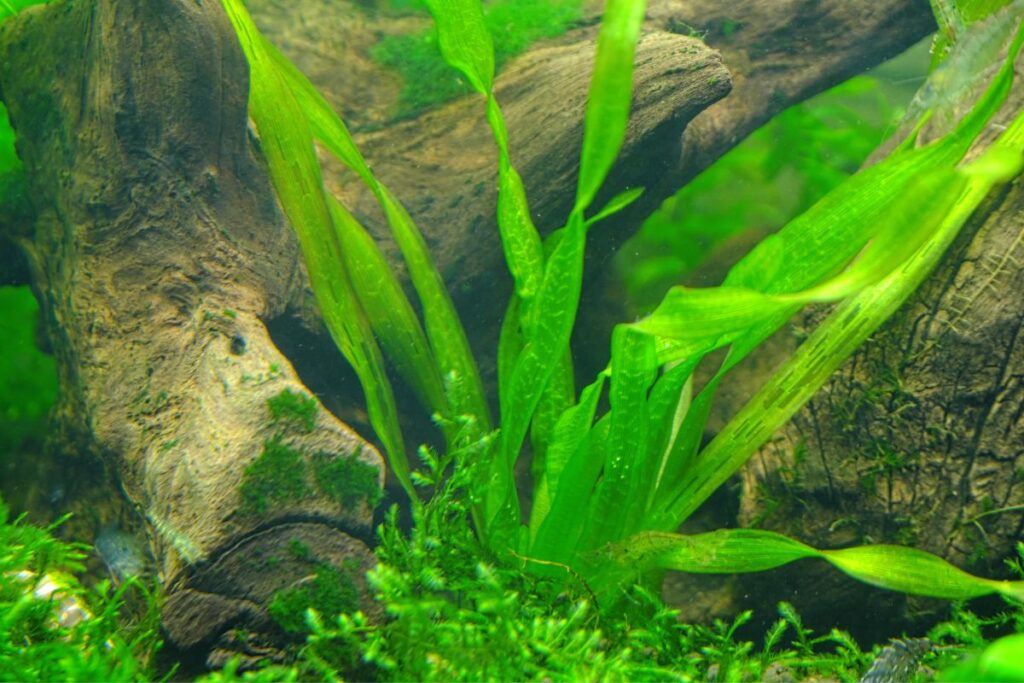
If you want to add some visual interest and break up the straight lines in your tank, Vallisneria spiralis could be a great choice for you. It grows quickly and has bright green leaves that taper into a point, adding depth to your aquarium. I’ve found that growing Vallisneria in low light is possible, but it may not grow as quickly or as tall. It’s important to have a nutrient-rich substrate or fertilizers to encourage growth.
Water Wisteria
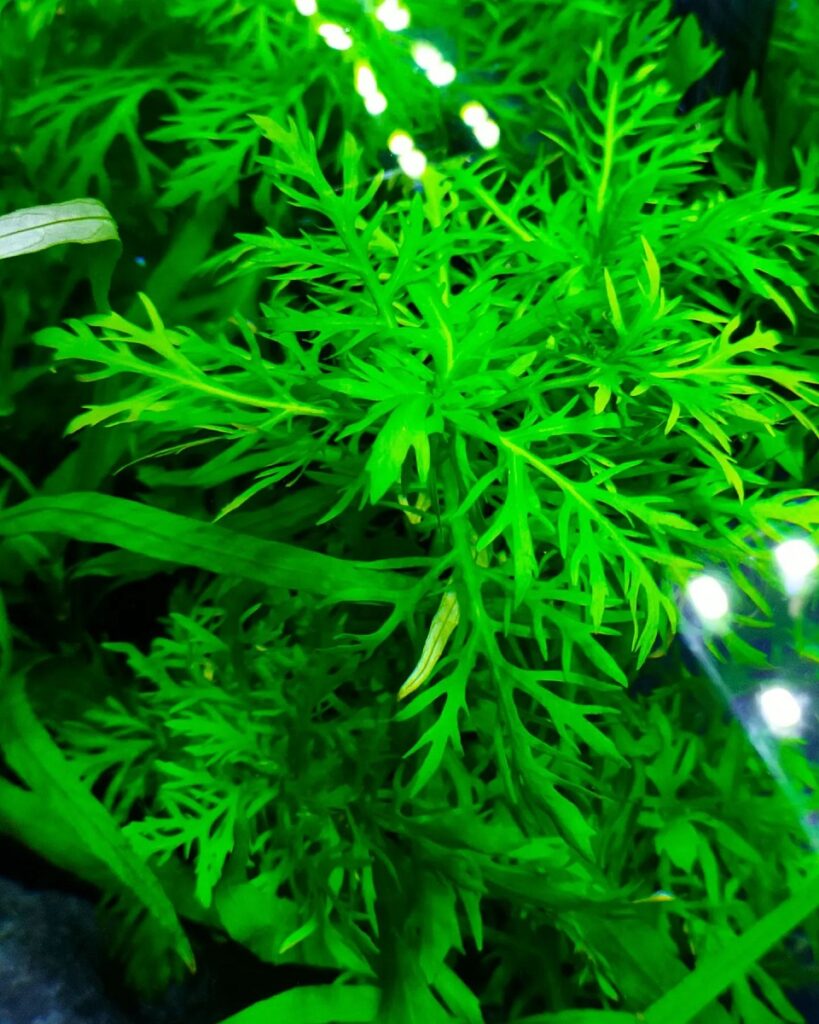
You’ll love Water Wisteria as a versatile option for adding texture and movement to your tank, with its delicate, feathery leaves that can grow up to 20 inches long. This beautiful plant is easy to care for and adapts well to different water conditions, making it a great choice for beginners. Growing techniques include providing moderate lighting and nutrient-rich substrate or fertilizers. CO2 supplementation isn’t necessary but can enhance growth.
Propagation methods include cutting the stem of the plant in half and planting both halves separately. Pruning tips involve trimming away any dead or discolored leaves, which will encourage new growth and keep the plant looking healthy. Water Wisteria is also known for being an excellent nitrate remover, helping to improve water quality in your aquarium. Overall, this fast-growing background plant will add a lush green touch to your tank while providing many benefits for your aquatic pets.
Pogostemon stellatus ‘octopus’
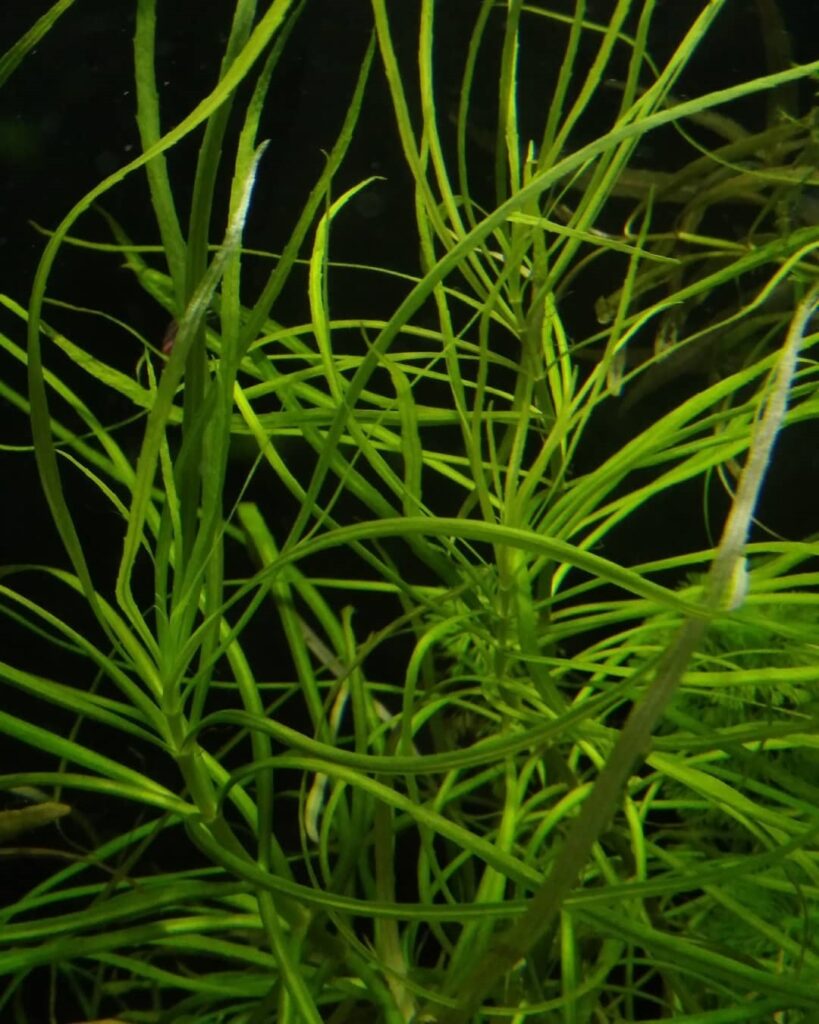
The Pogostemon stellatus ‘octopus’ is a unique and visually striking foreground plant with bright green leaves that can add a pop of color to any aquarium. It is an easy-to-propagate plant, making it a great option for those looking to expand their collection. Propagation techniques include simply pruning the stem and replanting it elsewhere in the tank.
This plant thrives in medium to high lighting conditions and appreciates nutrient-rich substrates or fertilizers. It is also compatible with other plants, such as Vallisneria spiralis or Amazon sword, making it a versatile addition to any aquarium. With its vibrant foliage and ease of care, the Pogostemon stellatus ‘octopus’ can be a perfect choice for beginners or experienced aquarists alike.
Moneywort
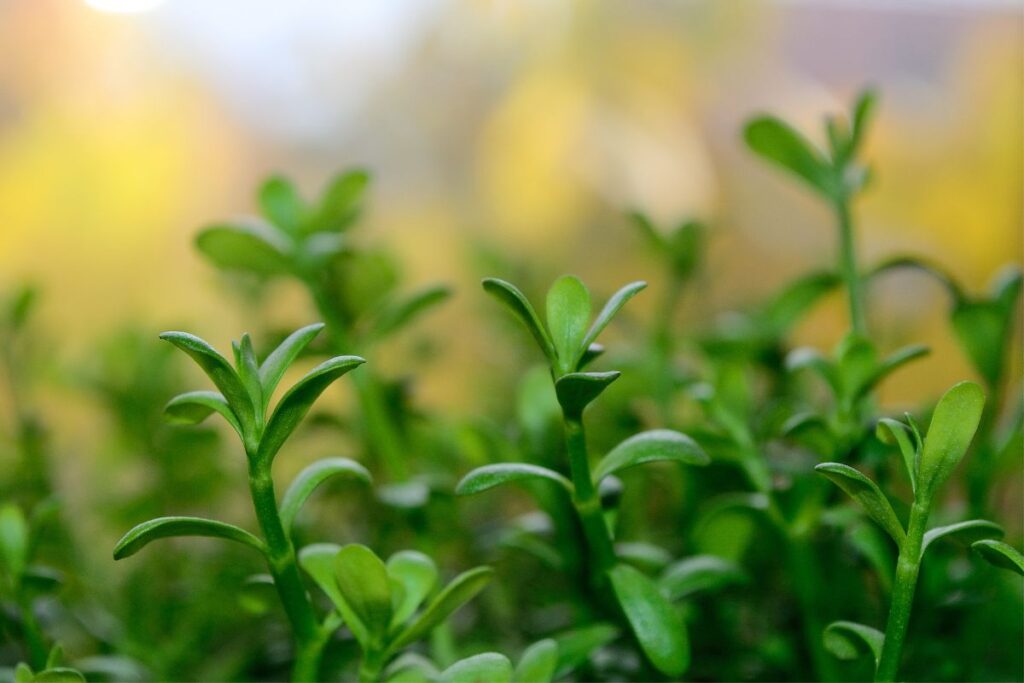
Looking for a colorful, low-maintenance addition to your aquarium? Check out the Moneywort plant! This stem plant, also known as Bacopa monnieri, has small, rounded leaves and sturdy, straight stems that can reach up to 18 inches in height. Moneywort is easy to care for and appreciates moderate lighting and nutrient-rich substrate or fertilizers. It can be propagated by pruning and replanting cuttings in the substrate.
Not only does moneywort add a pop of green color to your tank, but it also provides cover for fish and babies. Some great tank mates for moneywort include tetras, guppies, corydoras catfish, and bettas. When it comes to aquascaping with moneywort, try planting it on either side of a central focal point like a driftwood or rock structure to create balance in the tank. You can also plant it in clusters around taller background plants like Vallisneria spiralis or Rotala Indica for added dimension. With its versatility and ease of care, Moneywort is a great option for any aquarium enthusiast looking to add some color and texture to their tank.
Brazilian Pennywort
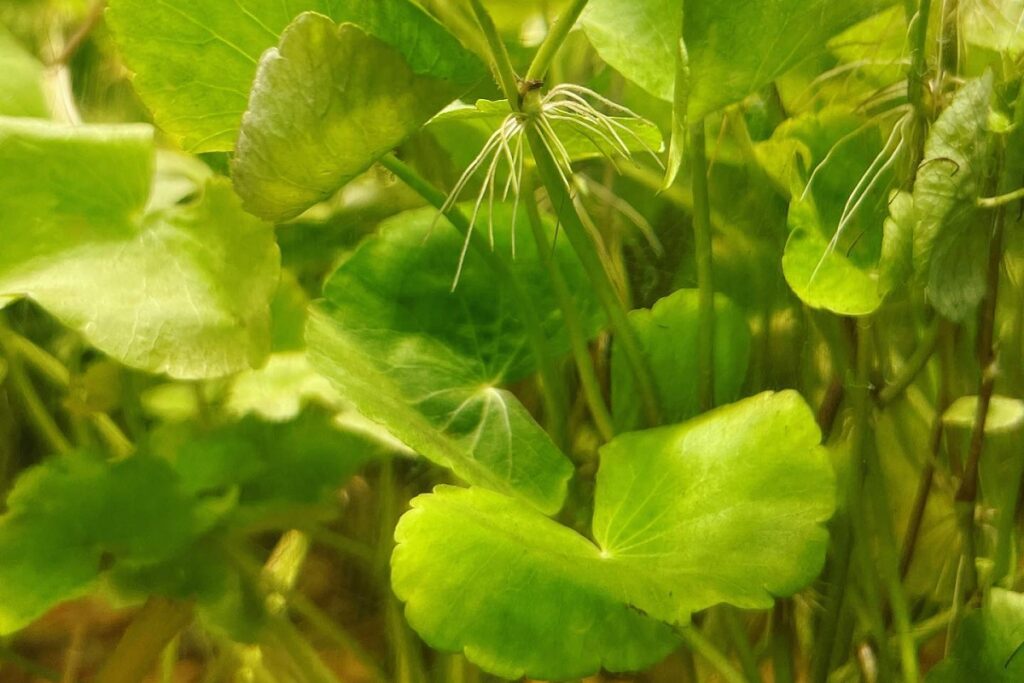
If you’re looking for a vibrant, fast-growing plant to add some movement to your aquatic landscape, Brazilian pennywort is definitely worth considering. This stem plant has small, round leaves that grow in clusters along its long stems, creating a dense and lush backdrop for your tank. It’s also incredibly easy to care for and can adapt to a variety of tank conditions.
Growing tips for Brazilian pennywort include providing it with moderate lighting and nutrient-rich substrate or fertilizers. It appreciates temperatures between 72-82°F and pH levels around 6.0-7.5. Propagation methods include simply cutting off the top portion of the stem and replanting it in the substrate. With proper care, this plant can grow up to two inches per week, making it an excellent choice for those looking to quickly fill their aquarium with greenery. Overall, Brazilian pennywort is an ideal addition to any beginner or experienced aquarist’s collection of aquatic plants due to its low maintenance requirements and ability to thrive in varying tank conditions while adding color and texture to the background of any aquarium setting.
Cryptocoryne Balansae
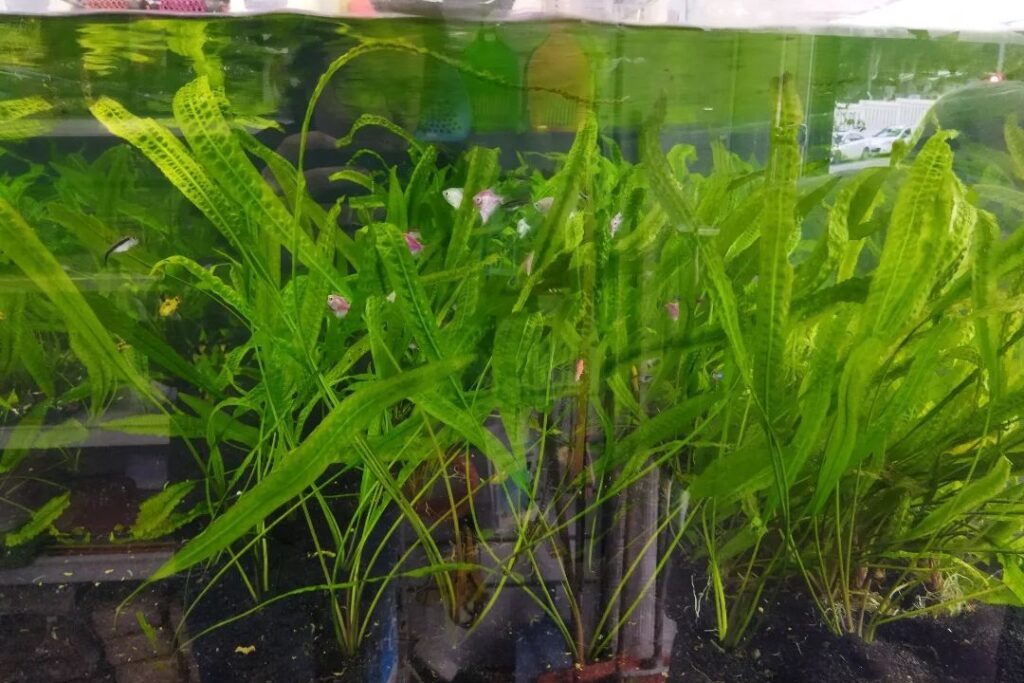
You’ll love the unique look and easy care of Cryptocoryne Balansae, which offers a range of shapes and hues to add character to your aquatic landscape. This plant is perfect for beginners as it does not require much maintenance. It can tolerate lower lighting conditions but will thrive with moderate to high lighting. You can also use nutrient-rich substrate or fertilizers to boost its growth.
If you want to propagate Cryptocoryne Balansae, you can simply separate the plant’s roots and replant them in different areas of the tank. However, be careful not to disturb the roots too much as this can cause damage or death to the plant. With proper care and attention, Cryptocoryne Balansae can grow up to 18 inches tall, making it an attractive background plant for any aquarium. So go ahead and add this versatile plant to your collection!
Water Sprite

You’ll love the lush, vibrant green of water sprite as it floats effortlessly near the surface, bringing an added dimension to your aquarium. This beginner-friendly plant is easy to care for and can be propagated easily by pruning and replanting. Water Sprite appreciates medium to high lighting and can help purify water while providing cover for fish and babies. Its flat, circular leaves make a great addition to any aquascape.
In terms of benefits for fish and water quality, water sprite has been known to remove nitrates from the water column, which helps reduce the risk of algae growth. Additionally, its dense foliage provides hiding places for shy fish or fry while also oxygenating the tank through photosynthesis. With its versatility in placement – whether floating at the surface or anchored in the substrate – and low maintenance requirements, water sprite is a great option for new aquarium hobbyists looking to add some life to their tanks.
Ludwigia Repens
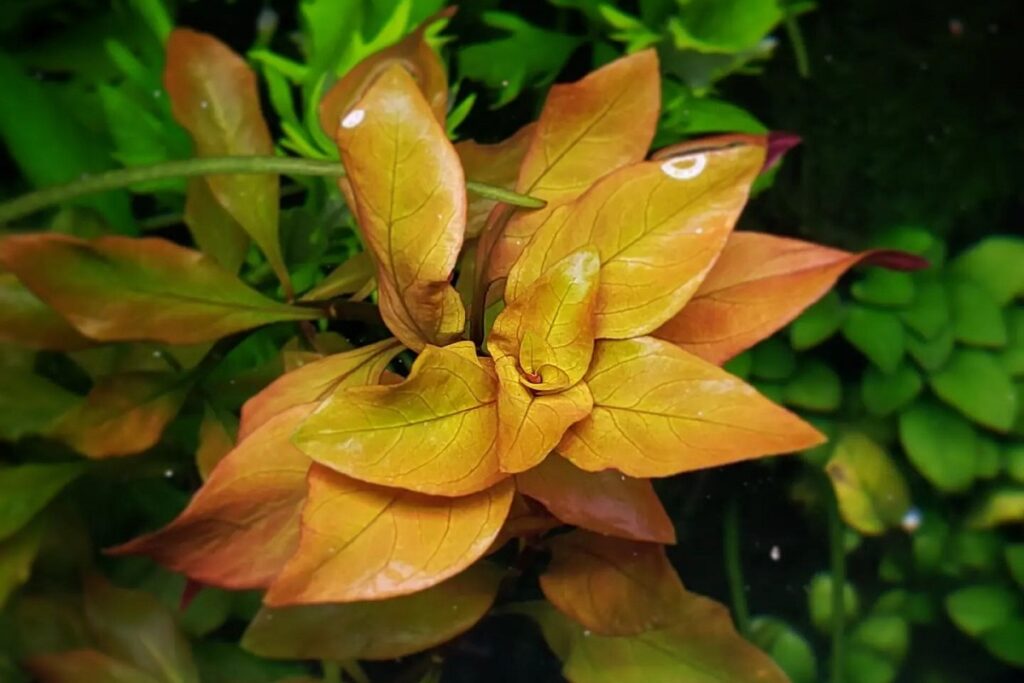
Ludwigia Repens is a great choice for aquarium enthusiasts looking for a versatile, fast-growing plant that can thrive in tanks of all sizes. As someone who has personally grown this plant, I can attest to its ability to add an eye-catching pop of color to any tank. Its leaves range from green to red and the stem produces tiny oxygen bubbles, making it not only aesthetically pleasing but also beneficial for your fish.
Growing tips for Ludwigia Repens include providing it with nutrient-rich substrate and regular dosing of aquarium plant supplements. It appreciates moderate to high lighting and does well in water temperatures ranging from 72-82°F. Maintenance requirements include pruning techniques such as pinching off the tops of stems or cutting back any damaged leaves. With proper care, Ludwigia Repens can grow tall and wide, making it a great option for filling out empty spaces in your tank’s background.
Amazon Sword

The Amazon sword, known for its low maintenance and ability to reach heights of over 20 inches tall, is a popular option among beginner aquarium enthusiasts. As someone who values safety and simplicity in their aquatic hobby, the Amazon sword has been a great addition to my tank. Care tips include providing good lighting and nutrient-rich substrate for optimal growth. Regular pruning can also help maintain its size.
Propagation techniques for the Amazon sword are fairly straightforward – simply cut off runners or side shoots and replant them in the substrate. It’s always satisfying to see new growth sprouting from these cuttings! As far as tankmates go, the Amazon sword can stand up to larger fish like cichlids and goldfish. However, be cautious when adding smaller fish as they may nibble on the leaves. Overall, I highly recommend this beautiful and easy-to-care-for plant for any aquarium enthusiast looking to create a natural environment for their fish.
Rotala Rotundifolia Red
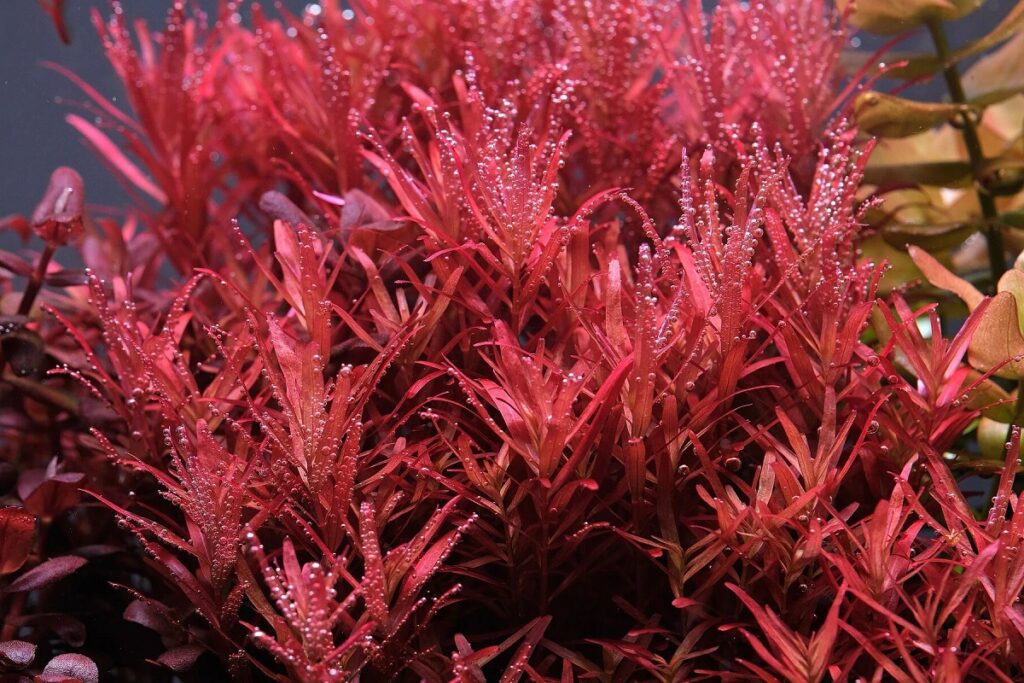
If you’re looking to add a pop of color to your tank, Rotala rotundifolia Red is a great option. This plant has a distinct shape and can create tiny oxygen pearls that add movement to your aquarium. It appreciates nutrient-rich substrate and CO2 supplementation, so it’s important to make sure you have these elements in place before adding this plant.
To keep Rotala rotundifolia Red healthy, regular pruning techniques are necessary. This will help the plant maintain its shape and prevent it from becoming too overgrown. With proper care, this colorful background plant can thrive in your aquarium and provide a beautiful addition to your underwater world.
Bacopa Caroliniana
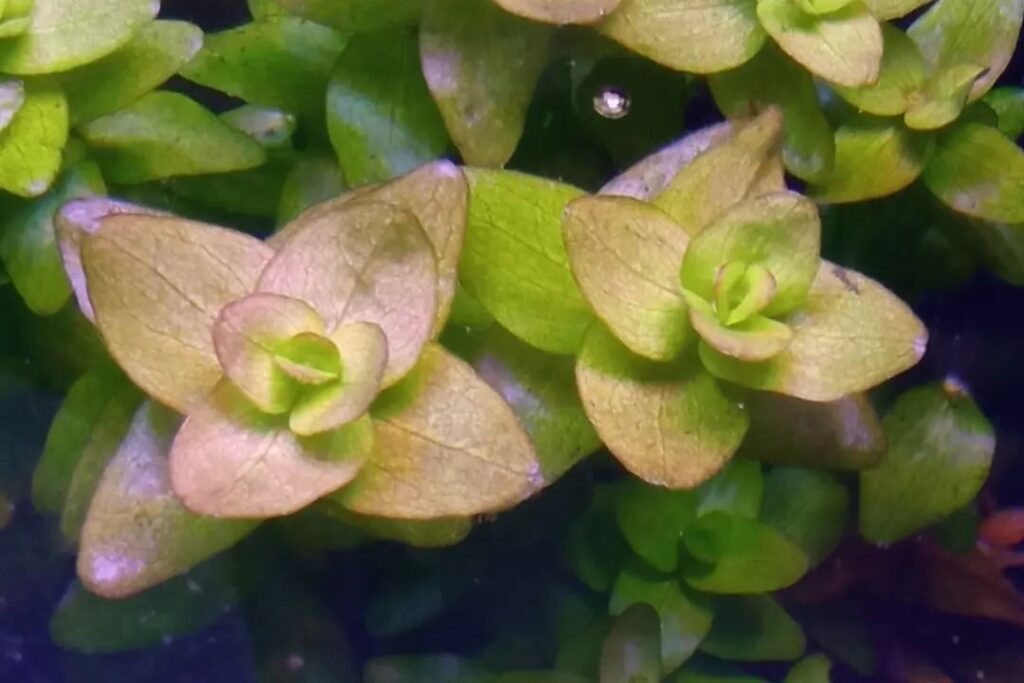
You should consider adding Bacopa caroliniana to your tank if you want a plant that can add variety in color and texture. This aquatic plant has clusters of oval-shaped leaves and long stems that can create a lush background for your aquarium. Bacopa caroliniana is also easy to propagate by pruning and replanting the cuttings.
To ensure the best growth for Bacopa caroliniana, it’s important to provide medium to high lighting conditions. It also appreciates nutrient-rich substrate or regular dosing of fertilizers. This versatile plant can be used as both a background or mid-ground plant, and it’s known for its ability to purify water. Careful maintenance including pruning and water changes is necessary, but with proper care, Bacopa caroliniana can thrive in any aquarium setting.
Egeria Densa (Anacharis)

Moving on from Bacopa caroliniana, let’s talk about Egeria Densa, also known as Anacharis. This plant is a popular choice for beginners because it’s easy to care for and can grow in almost any condition. When planting Egeria Densa, make sure the roots are buried in the substrate and the stem is floating at the surface of the water. It’s important to note that this plant can grow very quickly, so regular pruning may be necessary to prevent it from taking over your tank.
Incorporating Egeria Densa into aquascapes is a great way to add some natural beauty while also helping to maintain water quality. This plant absorbs nitrates and other harmful chemicals from the water, making it a great addition for both you and your fish. Plus, its long stems can create a beautiful backdrop or provide shelter for fish who like to hide among plants. Overall, Egeria Densa is an excellent choice for anyone looking to add some greenery without too much hassle.
Alternanthera reineckii var. ‘roseafolia’
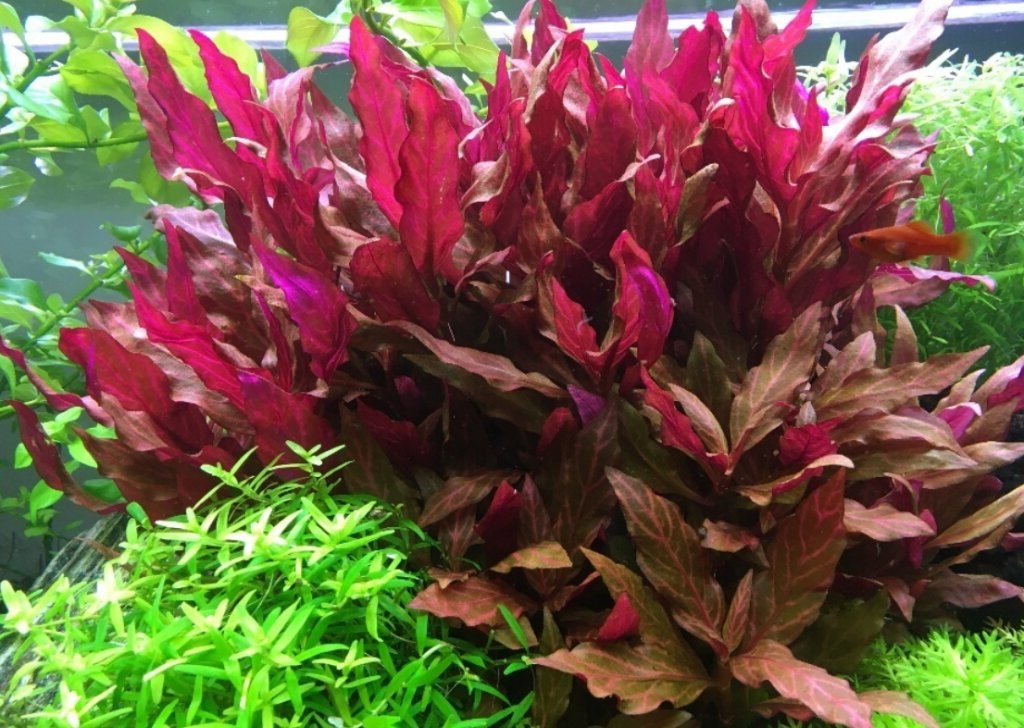
When adding Alternanthera reineckii var. ‘roseafolia’ to your tank, you’ll be rewarded with the vibrant colors of its pink and red leaves that make it a standout among other plant options. This stem plant is relatively easy to care for and can grow up to 20 inches tall, making it an ideal background plant. To ensure its growth and coloration, provide moderate to high lighting and nutrient-rich substrate or fertilizers. CO2 supplementation is also recommended for optimal growth.
There are several color variations of this plant available, ranging from bright green leaves with red highlights to deep burgundy leaves. Its unique coloring adds variety and interest to any aquarium setup. Propagation methods include pruning stems at the base of the plant and replanting in fresh substrate. With proper care, Alternanthera reineckii var. ‘roseafolia’ can thrive in a range of water temperatures from 64-82°F, making it suitable for many different types of fish tanks.
Cryptocoryne Retrospiralis
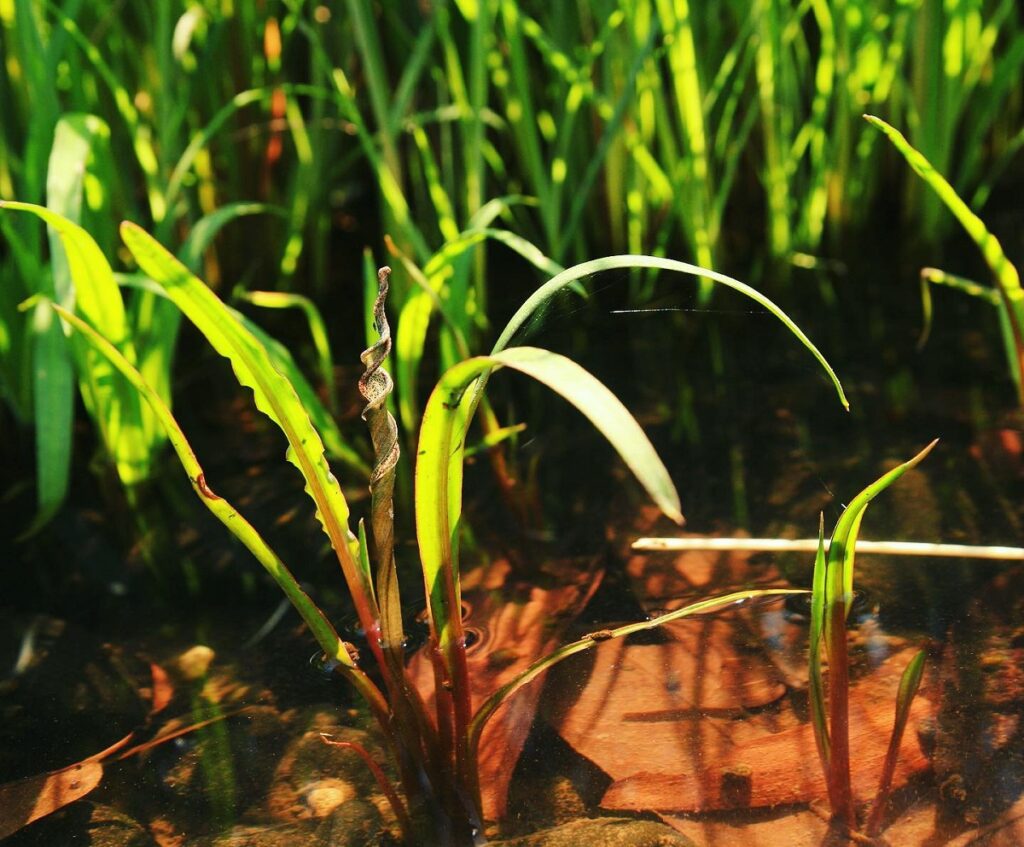
If you’re looking for a plant that offers a unique look with its long, ruffled leaves and comes in many different shapes and hues, consider adding Cryptocoryne Retrospiralis to your tank. This background plant is a great choice for those who want to add some variety in color and texture. The benefits of this plant include its ability to purify water and provide cover for fish and babies. It’s also hardy and versatile, making it an excellent option for any aquarium.
When caring for Cryptocoryne Retrospiralis, it’s important to note that it prefers nutrient-rich substrate or fertilizers. Additionally, regular dosing of aquarium plant supplements may be necessary. This slow-growing plant can be propagated by separating the rhizome into smaller pieces and replanting them in the substrate. Overall, if you’re looking for a visually stunning addition to your aquarium that requires minimal maintenance but still adds value to your tank ecosystem, Cryptocoryne Retrospiralis is definitely worth considering.
Pearl Weed
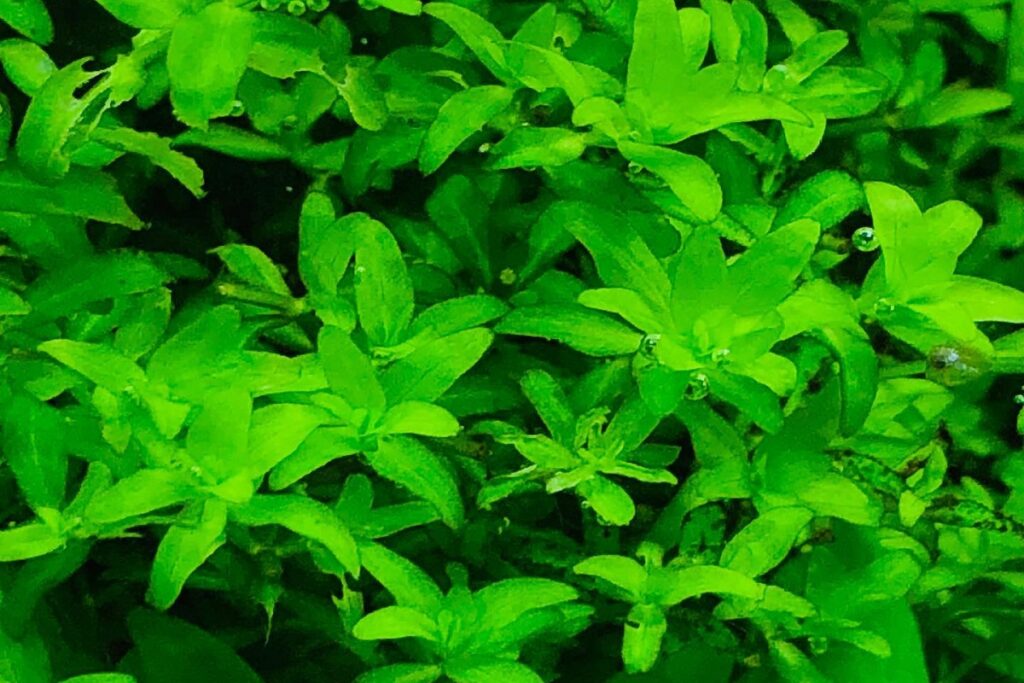
You’ll love how Pearl weed adds a unique touch to your tank with its tiny, round leaves and fast growth rate. This easy-to-grow stem plant is perfect for beginners who want to add some variety to their aquarium without too much maintenance. One of the benefits of pearl weed is that it can be used as either a foreground or background plant, depending on how you trim it. Its small size makes it perfect for filling in gaps between larger plants, while its fast-growing nature allows it to quickly cover the back of your tank.
Taking care of pearl weed is relatively simple. It prefers medium lighting and nutrient-rich substrate but can adapt to various water conditions. Propagation is also straightforward – simply cut off a section and replant it into the substrate. Compared to other easy-to-grow stem plants like hornwort or water sprite, pearl weed’s small size and unique appearance make it stand out in any aquascape. When using pearl weed as a background plant, try planting taller stems at the back and gradually trimming them shorter towards the front for a layered effect.
Hornwort
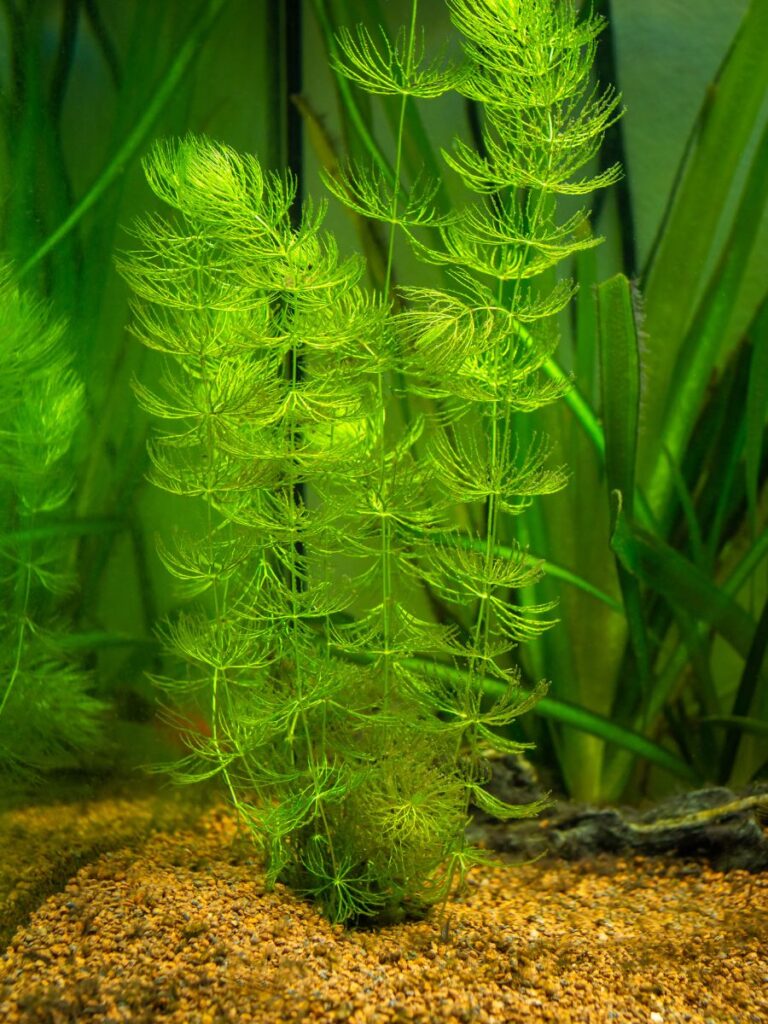
Looking for an easy-to-care-for plant that can add a unique touch to your tank? Check out Hornwort, a fast-growing stem plant with feathery foliage and versatile nature. One of the benefits of hornwort is its ability to quickly absorb excess nutrients from the water, helping to keep the tank clean and healthy for fish. Additionally, its dense growth pattern provides ample cover for fish and fry.
Hornwort prefers moderate to high lighting and can thrive in a range of temperatures from 59-86°F. It can be propagated easily by snipping off stems and replanting them in the substrate or floating them on the surface of the water. With its low-maintenance nature and versatility, hornwort is a great addition to any aquarium, especially for beginners looking to add some greenery to their tanks without much effort.
Tiger Lotus
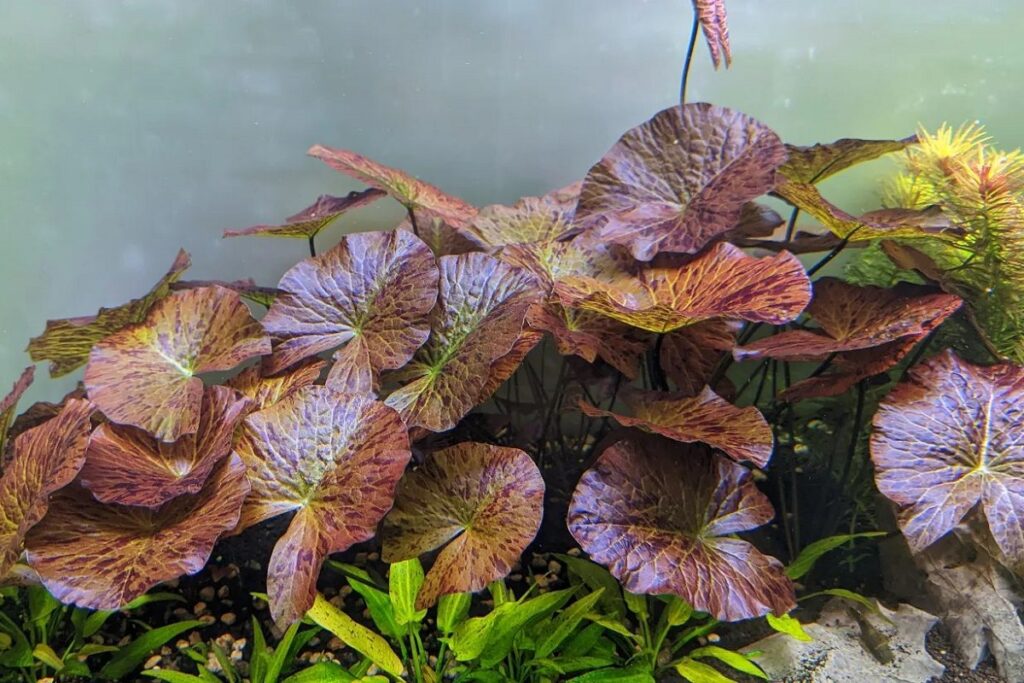
Have you considered adding a tiger lotus to your tank? This stunning plant has large, vibrant leaves that can range from green to red and can grow up to 20 inches tall, creating a beautiful focal point in your aquarium. Growing tiger lotus is relatively easy as they appreciate nutrient-rich substrates and moderate lighting. They also require regular fertilization and pruning to prevent overcrowding.
Tiger lotus care tips include keeping the water temperature between 72-82°F and providing them with at least six hours of light per day. They are a hardy plant that can stand up to most fish and are known for their ability to reduce algae growth in the tank. Decorating with tiger lotus is a great way to add color and texture to your aquarium, while also providing hiding spots for fish and babies. Overall, this plant is a fantastic addition for any aquarist looking for an eye-catching background plant that is easy to care for.
Guppy Grass
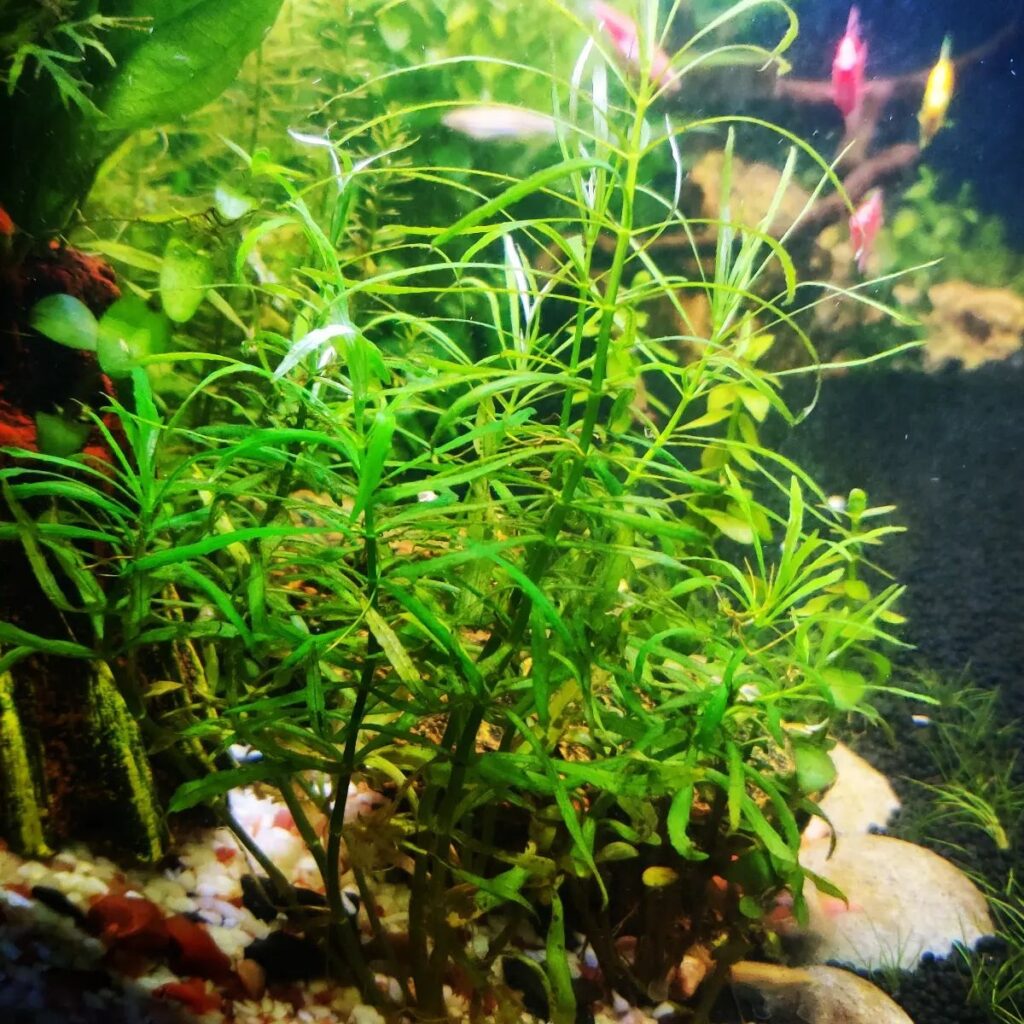
Moving on from tiger lotus, let’s explore another great background plant for aquariums – guppy grass. This versatile and easy-to-care-for plant is perfect for any beginner looking to add some greenery to their tank. Not only does it provide cover for fish and shrimp, but it also helps purify the water by absorbing excess nutrients.
One of the best benefits of guppy grass is its propagation techniques. It can be easily propagated by simply trimming the stems and replanting them in the substrate. This makes it a cost-effective option for those looking to fill up their tank without breaking the bank. Additionally, guppy grass requires minimal care with regard to lighting and fertilization, making it a low-maintenance choice for beginners. Just ensure that you don’t overcrowd your tank with too much guppy grass as it may lead to poor oxygenation levels in the water.
Crinum Calamistratum

If you’re looking for a unique and slow-growing background plant that adds texture and depth to your aquarium, you might consider adding Crinum calamistratum. This plant produces long, tough, ruffled leaves that can grow up to three feet long. Care tips for crinum calamistratum include planting it in a nutrient-rich substrate and providing moderate lighting. It can also be propagated through bulb division.
Decorating ideas using crinum calamistratum in aquariums include planting it at the back of the tank to add height and visual interest. Its long leaves can provide cover for fish and babies while creating a natural environment. Additionally, crinum calamistratum is known to help purify water by absorbing nitrates and other toxins from the water column, benefiting fish health and the overall aquarium environment.
African Water Fern
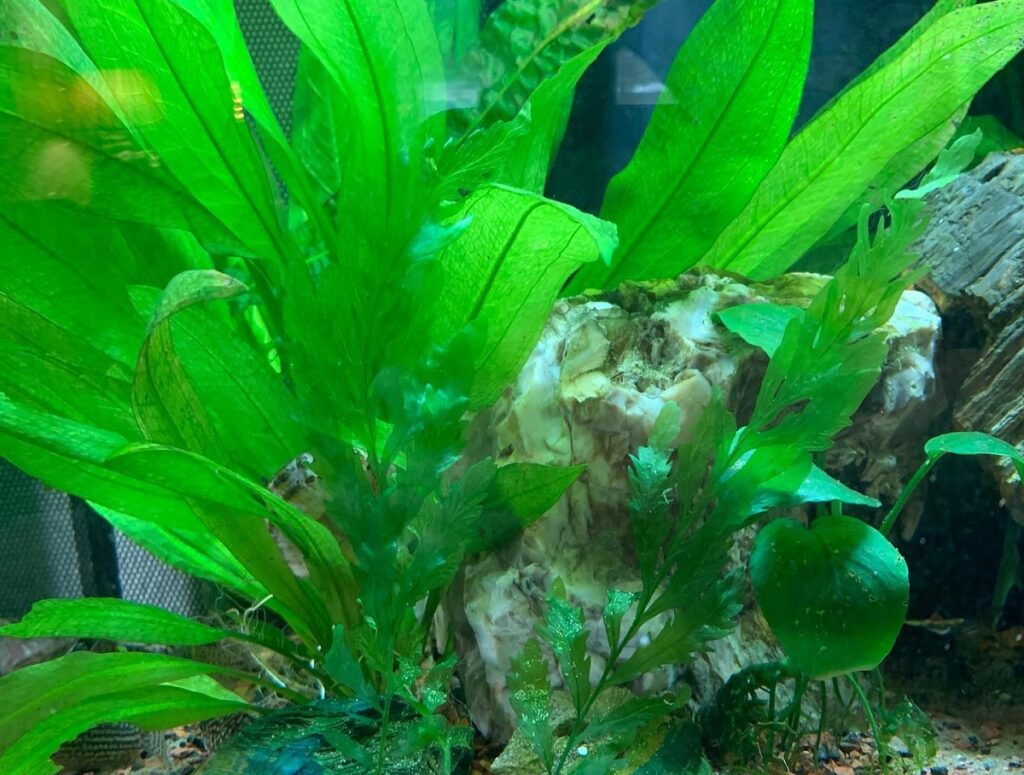
Looking for a unique and eye-catching addition to your aquarium that can improve water quality and provide cover for your fish? Consider adding African Water Fern to your tank! This plant, also known as Bolbitis heudelotii, is a slow-growing fern that can thrive in low to medium light conditions. It prefers soft, slightly acidic water with a pH range of 6.0-7.5 and temperatures between 72-82°F.
Growing tips for African Water Fern include attaching it to driftwood or rocks using fishing line or thread until its roots have established themselves. The plant should be placed in the background of the tank, as it can grow up to 12 inches tall and up to 10 inches wide. Care requirements are minimal, as this fern does not require CO2 supplementation or nutrient-rich substrates. It benefits the aquarium by providing shade and cover for fish while helping to purify the water by absorbing excess nitrates and phosphates. Overall, African Water Fern is an excellent choice for those looking to add some variety and natural beauty to their tank without requiring too much maintenance.
Conclusion
So there you have it, my top 20 beginner-friendly background plants for aquariums! Remember to choose plants that fit the needs of your specific tank, and don’t be afraid to experiment with different species. Live plants can add so many beauty and health benefits to your aquatic environment, so take the time to research and select the right ones for you.
If you’re new to incorporating live plants into your aquarium, don’t worry – there are plenty of resources available online and at your local fish store. With a little patience and care, you can create a stunning underwater world that both you and your fish will enjoy. Happy planting!
